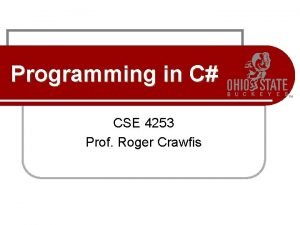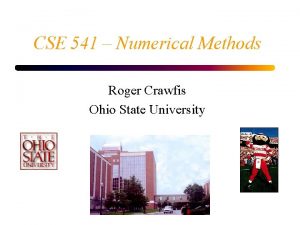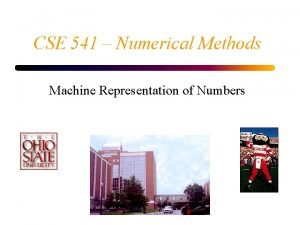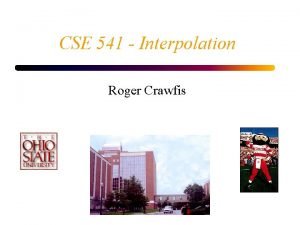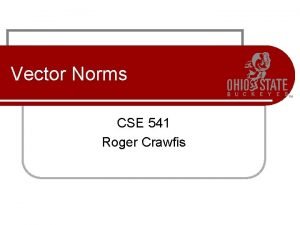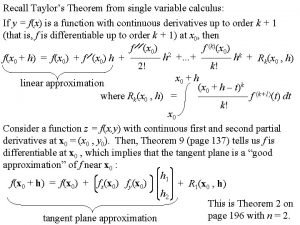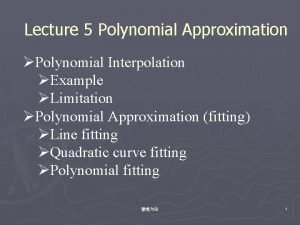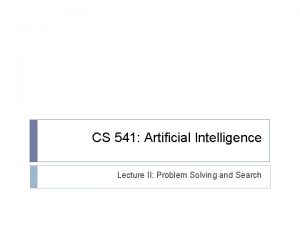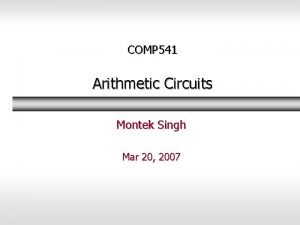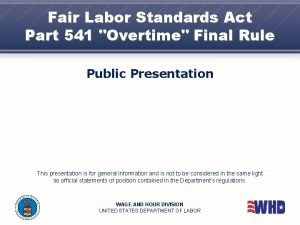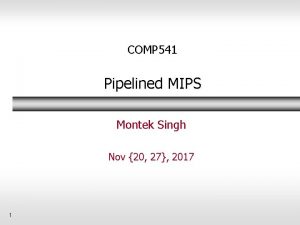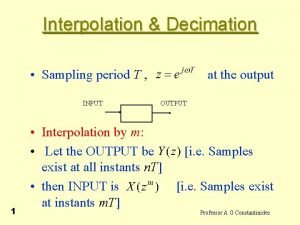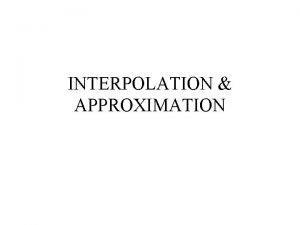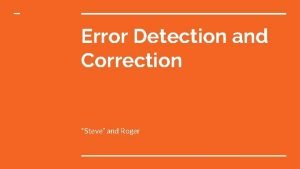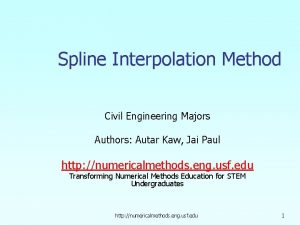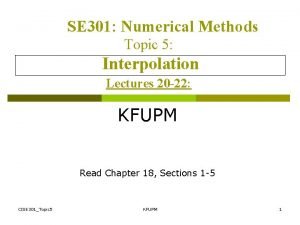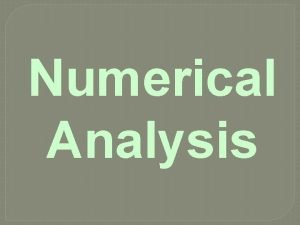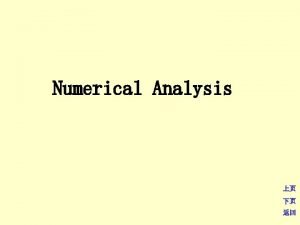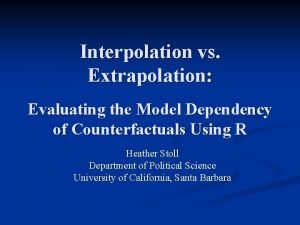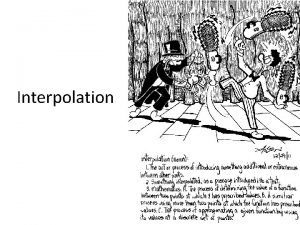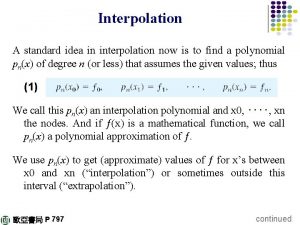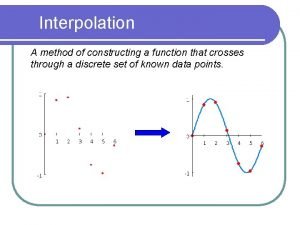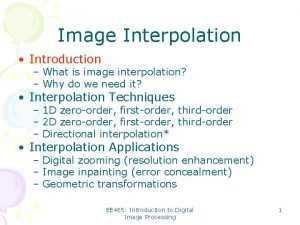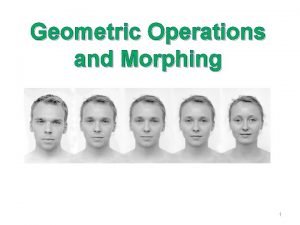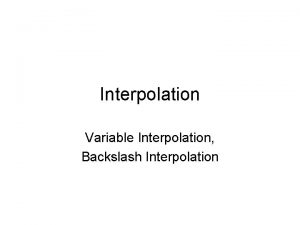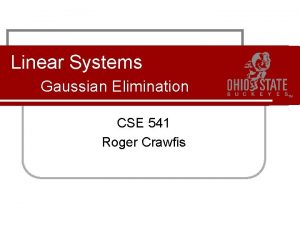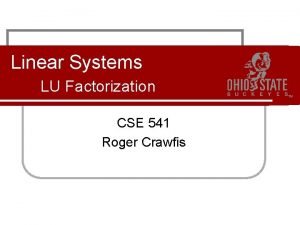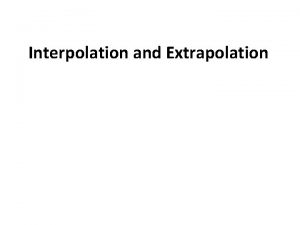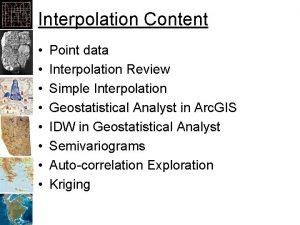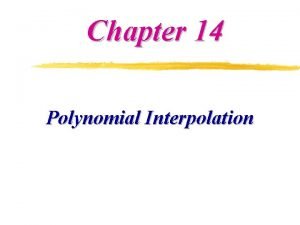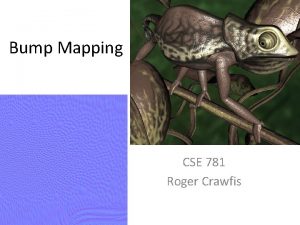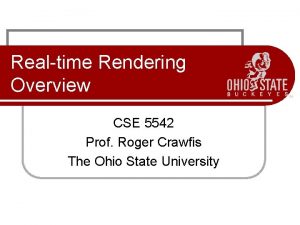CSE 541 Interpolation Roger Crawfis Taylors Series and

















































- Slides: 49

CSE 541 - Interpolation Roger Crawfis

Taylor’s Series and Interpolation • Taylor Series interpolates at a specific point: – The function – Its first derivative –… • It may not interpolate at other points. • We want an interpolant at several f(c)’s. 02 November 2020 OSU/CIS 541 2

Basic Scenario • We are able to prod some function, but do not know what it really is. • This gives us a list of data points: [xi, fi] f(x) fi fi+1 xi xi+1 02 November 2020 OSU/CIS 541 3

Interpolation & Curve-fitting • Often, we have data sets from experimental/observational measurements – Typically, find that the data/dependent variable/output varies… – As the control parameter/independent variable/input varies. Examples: • Classic gravity drop: location changes with time • Pressure varies with depth • Wind speed varies with time • Temperature varies with location • Scientific method: Given data identify underlying relationship • Process known as curve fitting: 02 November 2020 OSU/CIS 541 4

Interpolation & Curve-fitting • Given a data set of n+1 points (xi, yi) identify a function f(x) (the curve), that is in some (well-defined) sense the best fit to the data • Used for: – Identification of underlying relationship (modelling/prediction) – Interpolation (filling in the gaps) – Extrapolation (predicting outside the range of the data) 02 November 2020 OSU/CIS 541 5

Interpolation Vs Regression • Distinctly different approaches depending on the quality of the data • Consider the pictures below: extrapolate interpolate extrapolate Pretty confident: there is a polynomial relationship Little/no scatter Want to find an expression that passes exactly through all the points 02 November 2020 OSU/CIS 541 Unsure what the relationship is Clear scatter Want to find an expression that captures the trend: minimize some measure of the error Of all the points… 6

Interpolation • Concentrate first on the case where we believe there is no error in the data (and round-off is assumed to be negligible). • So we have yi=f(xi) at n+1 points x 0, x 1…xi, …xn: xj > xj-1 • (Often but not always evenly spaced) • In general, we do not know the underlying function f(x) • Conceptually, interpolation consists of two stages: – Develop a simple function g(x) that • Approximates f(x) • Passes through all the points xi – Evaluate f(xt) where x 0 < xt < xn 02 November 2020 OSU/CIS 541 7

Interpolation • Clearly, the crucial question is the selection of the simple functions g(x) • Types are: – – Polynomials Splines Trigonometric functions Spectral functions…Rational functions etc… 02 November 2020 OSU/CIS 541 8

Curve Approximation • We will look at three possible approximations (time permitting): – Polynomial interpolation – Spline (polynomial) interpolation – Least-squares (polynomial) approximation • If you know your function is periodic, then trigonometric functions may work better. – Fourier Transform and representations 02 November 2020 OSU/CIS 541 9

Polynomial Interpolation • Consider our data set of n+1 points yi=f(xi) at n+1 points x 0, x 1…xi, …xn: xj > xj-1 • In general, given n+1 points, there is a unique polynomial gn(x) of order n: • That passes through all n+1 points 02 November 2020 OSU/CIS 541 10

Polynomial Interpolation • There a variety of ways of expressing the same polynomial • Lagrange interpolating polynomials • Newton’s divided difference interpolating polynomials • We will look at both forms 02 November 2020 OSU/CIS 541 11

Polynomial Interpolation • Existence – does there exist a polynomial that exactly passes through the n data points? • Uniqueness – Is there more than one such polynomial? – We will assume uniqueness for now and prove it latter. 02 November 2020 OSU/CIS 541 12

Lagrange Polynomials • Summation of terms, such that: – Equal to f() at a data point. – Equal to zero at all other data points. – Each term is a nthdegree polynomial Existence!!! 02 November 2020 OSU/CIS 541 13

Linear Interpolation • Summation of two lines: Remember this when we talk about piecewise-linear splines x 0 02 November 2020 x 1 OSU/CIS 541 14

Lagrange Polynomials • 2 nd Order Case => quadratic polynomials third quadratic hashas Adding them all together, The first quadratic has roots second quadratic roots atthe xx 0 2 and a we interpolating at xget andxa 12 and value 1 and value to equal to the function quadratic polynomial, such equal the function data that: at x 0. at x 21. • P(x 0) = f 00 • P(x 1) = 0 f 1 • P(x 2 ) = 0 f 21 02 November 2020 x 0 OSU/CIS 541 x 2 15

Lagrange Polynomials • Sum must be a unique 2 nd order polynomial through all the data points. • What is an efficient implementation? 02 November 2020 OSU/CIS 541 16

Newton Interpolation • • Consider our data set of n+1 points yi=f(xi) at x 0, x 1…xi, …xn: xn > x 0 Since pn(x) is the unique polynomial pn(x) of order n, write it: • • f[xi, xj] is a first divided difference f[x 2, x 1, x 0] is a second divided difference, etc. 02 November 2020 OSU/CIS 541 17

Invariance Theorem • Note, that the order of the data points does not matter. • All that is required is that the data points are distinct. • Hence, the divided difference f[x 0, x 1, …, xk] is invariant under all permutations of the xi‘s. 02 November 2020 OSU/CIS 541 18

Linear Interpolation • Simple linear interpolation results from having only 2 data points. slope x 0 02 November 2020 x 1 OSU/CIS 541 19

Quadratic Interpolation • Three data points: 02 November 2020 OSU/CIS 541 20

Newton Interpolation • Let’s look at the recursion formula: • For the quadratic term: 02 November 2020 OSU/CIS 541 21

Evaluating for x 2 02 November 2020 OSU/CIS 541 22

Example: ln(x) • Interpolation of ln(2): given ln(1); ln(4) and ln(6) ted c – Data points: {(1, 0), (4, 1. 3863), (6, 1. 79176)} rr e co – Linear Interpolation: 0 + {(1. 3863 -0)/(4 -1)}(x-1) = 0. 4621(x-1) – Quadratic Interpolation: 0. 4621(x-1)+((0. 20273 -0. 4621)/5)(x-1)(x-4) = 0. 4621(x-1) - 0. 051874 (x-1)(x-4) Note the divergence for values outside of the data range. 02 November 2020 OSU/CIS 541 23

Example: ln(x) • Quadratic interpolation catches some of the curvature • Improves the result somewhat • Not always a good idea: see later… 02 November 2020 OSU/CIS 541 24

Calculating the Divided-Differences • A divided-difference table can easily be constructed incrementally. • Consider the function ln(x). 02 November 2020 OSU/CIS 541 25

Calculating the Divided-Differences 02 November 2020 OSU/CIS 541 26

Calculating the Divided-Differences 02 November 2020 OSU/CIS 541 27

Calculating the Divided-Differences 02 November 2020 OSU/CIS 541 28

Calculating the Divided-Differences 02 November 2020 OSU/CIS 541 29

Calculating the Divided-Differences 02 November 2020 OSU/CIS 541 30

Calculating the Divided-Differences 02 November 2020 OSU/CIS 541 31

Calculating the Divided-Differences • Finally, we can calculate the last coefficient. 02 November 2020 OSU/CIS 541 32

Calculating the Divided-Differences • All of the coefficients for the resulting polynomial are in bold. b 0 b 4 b 7 02 November 2020 OSU/CIS 541 33

Polynomial Form for Divided. Differences • The resulting polynomial comes from the divided-differences and the corresponding product terms: 02 November 2020 OSU/CIS 541 34

Many polynomials • Note, that the order of the numbers (xi, yi)’s only matters when writing the polynomial down. – The first column represents the set of linear splines between two adjacent data points. – The second column gives us quadratics thru three adjacent points. – Etc. 02 November 2020 OSU/CIS 541 35

Adding an Additional Data Point • Adding an additional data point, simply adds an additional term to the existing polynomial. – Hence, only n additional divided-differences need to be calculated for the n+1 st data point. b 8 02 November 2020 OSU/CIS 541 36

Adding More Data Points • Quadratic interpolation: – does linear interpolation – Then add higher-order correction to catch the curvature • Cubic, … • Consider the case where the data points are organized such the first two are the endpoints, the next point is the mid-point, followed by successive mid-points of the half-intervals. – Worksheet: f(x)=x 2 from -1 to 3. 02 November 2020 OSU/CIS 541 37

Uniqueness • Suppose that two polynomials of degree n (or less) existed that interpolated to the n+1 data points. • Subtracting these two polynomials from each other also leads to a polynomial of at most n degree. 02 November 2020 OSU/CIS 541 38

Uniqueness • Since p and q both interpolate the n+1 data points, • This polynomial r, has at least n+1 roots!!! • This can not be! A polynomial of degree-n can only have at most n roots. • Therefore, r(x) 0 02 November 2020 OSU/CIS 541 39

Example • Suppose f was a polynomial of degree m, where m<n. • Ex: f(x) = 3 x-2 • We have evaluations of f(x) at five locations: (-2, -8), (-1, -5), (0, -2), (1, 1), (2, 4) 02 November 2020 OSU/CIS 541 40

Error • Define the error term as: • If f(x) is an nth order polynomial pn(x) is of course exact. • Otherwise, since there is a perfect match at x 0, x 1, …, xn • This function has at least n+1 roots at the interpolation points. 02 November 2020 OSU/CIS 541 41

Interpolation Errors • Proof is in the book. • Intuitively, the first n+1 terms of the Taylor Series is also an nth degree polynomial. 02 November 2020 OSU/CIS 541 42

Interpolation Errors • Use the point x, to expand the polynomial. • Point is, we can take an arbitrary point x, and create an (n+1)th polynomial that goes thru the point x. 02 November 2020 OSU/CIS 541 43

Interpolation Errors • Combining the last two statements, we can also get a feel for what these divided differences represent. • Corollary 1 in book – If f(x) is a polynomial of degree m<n, then all (m+1)st divided differences and higher are zero. 02 November 2020 OSU/CIS 541 44

Problems with Interpolation • Is it always a good idea to use higher and higher order polynomials? • Certainly not: 3 -4 points usually good: 5 -6 ok: • See tendency of polynomial to “wiggle” • Particularly for sharp edges: see figures 02 November 2020 OSU/CIS 541 45

Chebyshev nodes • Equally distributed points may not be the optimal solution. • If you could select the xi’s, what would they be? • Want to minimize the term. • These are the Chebyshev nodes. – For x=-1 to 1: 02 November 2020 OSU/CIS 541 46

Chebyshev nodes • Let’s look at these for n=4. • Spreads the points out in the center. 02 November 2020 OSU/CIS 541 47

Polynomial Interpolation in Two-Dimensions • Consider the case in higher-dimensions. 02 November 2020 OSU/CIS 541 48

Finding the Inverse of a Function • What if I am after the inverse of the function f(x)? – For example arccos(x). • Simply reverse the role of the xi and the fi. 02 November 2020 OSU/CIS 541 49
 Cts in c#
Cts in c# Cse 541
Cse 541 Roger crawfis
Roger crawfis Roger crawfis
Roger crawfis Roger crawfis
Roger crawfis Cse 541
Cse 541 Cse 541
Cse 541 Cse 541
Cse 541 Norm of a vector
Norm of a vector S-o-r
S-o-r Taylors theorem
Taylors theorem Edward shih
Edward shih Taylor theorem
Taylor theorem Spline interpolation vs polynomial interpolation
Spline interpolation vs polynomial interpolation Cs 541 stevens
Cs 541 stevens Comp541
Comp541 Unc comp 541
Unc comp 541 Comp 541
Comp 541 Comp 541
Comp 541 541 ce
541 ce 29 cfr part 541
29 cfr part 541 Comp 541
Comp 541 Series aiding and series opposing
Series aiding and series opposing Maclaurin series vs taylor series
Maclaurin series vs taylor series Balmer series lyman series
Balmer series lyman series Taylor series of composite functions
Taylor series of composite functions Taylor series lesson
Taylor series lesson Ibm p series servers
Ibm p series servers Amplifier feedback topologies
Amplifier feedback topologies Arithmetic sequence formula
Arithmetic sequence formula Interpolation and decimation
Interpolation and decimation Central difference interpolation formula
Central difference interpolation formula Interpolation vs approximation
Interpolation vs approximation Anne hutchinson and roger williams
Anne hutchinson and roger williams Roger williams and anne hutchinson
Roger williams and anne hutchinson Steve and roger
Steve and roger Civil interpolation
Civil interpolation Interpolation method
Interpolation method (x+1)^3 formula
(x+1)^3 formula Interpolation in numerical methods
Interpolation in numerical methods Extrapolation vs interpolation
Extrapolation vs interpolation Inverse distance weighted interpolation formula
Inverse distance weighted interpolation formula Radial basis function interpolation matlab
Radial basis function interpolation matlab Cosh0
Cosh0 Site:slidetodoc.com
Site:slidetodoc.com Direct method of interpolation
Direct method of interpolation Interpolation irr formula
Interpolation irr formula Linear interpolation formula
Linear interpolation formula Bicubic interpolation
Bicubic interpolation Interpolation in economics
Interpolation in economics
